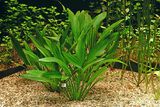
| light: | much-medium |
|---|---|
| temperature: | 18-28°C |
| Growth: | medium |
| Location: | background |
| height: | up to 60 cm |
| pH: | 5-8 |
| water hardness: | soft to hard |
| Co2: | 20-30mg/L |
| propagation: | adventitious plants
on the flower stalk |
Echinodorus argentinensis Rataj
heterotypic synonym of: Echinodorus grandiflorus (Cham. & Schltr.) Micheli[1]
Echinodorus argentensis was described by K. Rataj in 1970. Synonyms: E. ellipticus,Alisma grandiflora. Common in southern Brazil, Uruguay and some parts of Argentina. Under normal conditions the plant reaches a height of 80-120 cm and in the water column 20-35 cm. Leaves are oval or ovate, dense, dark green, with prominent veins, and are on petioles of equal length or shorter than the leaf blades. Emers leaves are oval, 15-26 long and 7-15 cm wide, with light cut lines and spots, up to 7 veins are visible. Stem erect, 0.9-1.5 m long, branched at the base of the inflorescence. Inflorescence usually consists of 12-16 flower whorls. Flowers are 3-4 cm in diameter, petals are white. Seeds up to 3 mm long with three glands arranged in a row. At home, this plant forms different forms depending on growing conditions and season. In summer it usually grows above water, and in winter - in the water column or shallow water. Plant size also varies depending on the growing environment. Plants growing in the water column are usually five times smaller than plants growing in wetlands. When cultivating this species in normal aquarium conditions, the winter underwater form can be achieved only after 2-3 years, provided that the plants have a well-developed and strong rhizome. Plants that have passed the acclimation period are more suitable for an aquarium. In the aquarium, plants of this species do not form inflorescences and daughter plants rarely appear on the rhizome. In a warm and humid greenhouse, they usually bloom only after 2-3 years. The resulting fruits are pre-dried; seeds sown in moist sand germinate at a temperature of 25-26°C. These plants are suitable for keeping in the greenhouse in the soil half-covered with water.
-
Echinodorus argentinensis Rataj[2]
- ↑ WFO (2021): Echinodorus argentinensis Rataj. Published on the Internet;http://www.worldfloraonline.org/taxon/wfo-0000766364. Accessed on: 31 May 2021
- ↑ Echinodorus argentinensis Rataj University of Wroclaw

